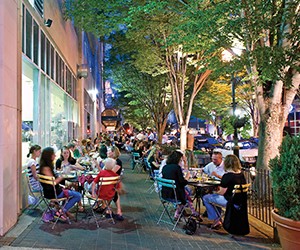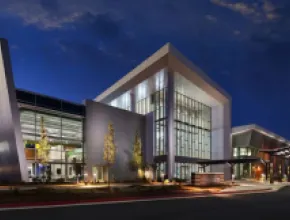Forming the Piedmont region’s “Triad” of cities, Greensboro, Winston-Salem and High Point, like North Carolina itself, are a study in product diversity, offering a complete package of commercial draws and cross-category assets for positive business outcomes and off-agenda rewards.
Alive with the arts, humming with history and economically vibrant, the Triad also presents a broad canvas for bringing ideas to life, including those for the silver screen.
Rebecca Clark, executive director of the Piedmont Triad Film Commission, offered this view: “Our diverse landscape provides rolling farmland, sprawling flat terrain, mountain settings and fantastic seasonal weather, all within a centrally located 12-county region,” she said. “We also have thriving cities with great amenities, quaint small towns and 18th century villages. It is this diversity that sets us apart from other areas of the state and the Southeast.”
Greensboro and Winston-Salem, about 30 miles apart along I-40 with High Point equidistantly just to the south, are just the ticket for discovering North Carolina’s picturesque, bountiful heartland.
Greensboro
As North Carolina’s long-time manufacturing center and third most populous city, business-friendly Greensboro draws diverse groups with a vibrant innovation-driven economy and more than 135 attractions, 500-plus area restaurants and close to 90 lodging options at varying price points.
“Centrally located on the East Coast along the interstate corridor, Greensboro is a convenient destination by plane, car or rail,” said Ava Pope, director of sales for the Greensboro Area CVB. “Home to the largest hotel and convention complex between Atlanta and Washington, D.C., a state-of-the-art Coliseum Complex and host of full-service hotels and resorts, Greensboro’s wealth of options encompasses first-rate shopping and dining, action-packed sports, museums, historic sites, family entertainment and outdoor activities galore.”
Formerly a textile town, Greensboro today is a leader in innovative manufacturing, including aerospace and defense, specialty composites, and wireless components and electronics. Supported by eleven colleges and universities and a highly skilled labor force, Greensboro is also strong in life sciences, with pioneering pharmaceutical companies, laboratory testing facilities and agricultural biotechnology firms located throughout the area, along with aviation, trucking and logistics.
Hosting some 800 annual events, the Greensboro Coliseum Complex, offering 197,000 total square feet of exhibit space, exemplifies the destination’s product versatility. Flexible by design, options include the 167,000-square-foot Special Events Center, partitionable into four halls; the 23,500-capacity Coliseum Arena and adjacent 2,376-seat War Memorial Auditorium; the intimate 298-seat Odeon Theatre; and the outdoor White Oak Amphitheatre, seating 7,688 people.
Sports are another major play in Greensboro. Part of basketball’s famed “Tobacco Road,” the city first hosted the Atlantic Coast Conference (ACC) men’s basketball tournament in 1966 and has been a championship event destination ever since. With ACC heroes honored at the complex’s Atlantic Coast Conference Hall of Champions, “Tournament Town” is also prominent on the PGA circuit as well as in all major aquatic sports, hosting collegiate, national and international events at the complex’s state-of-the-art Greensboro Aquatic Center. Groups can also catch Greensboro Grasshoppers baseball action at downtown’s event-capable NewBridge Bank Park, which features North Carolina’s largest outdoor sports bar, the Go Triad GrandStand.
Settled around 1740 and named “Greensborough” in 1808 for Revolutionary War hero Major General Nathanael Greene, Greensboro is also regarded as “the chosen center,” with heritage connections including the Greensboro Historical Museum, International Civil Rights Center & Museum and Guilford Courthouse National Military Park, where groups can catch the annual March reenactment of Greene’s valiant 1781 stand against the Redcoats.
Founded in 1962, ArtsGreensboro financially supports more than 50 arts organizations and projects each year, including September’s 17DAYS Arts & Culture Festival and the prestigious National Folk Festival, back for a third year in September 2017. Other cultural choices include the Weatherspoon Art Museum, Greensboro Symphony, Greensboro Ballet, Triad Stage and each May, the Carolina Blues Festival, which turned 30 this year.
Home of the SkyWild Treetop Adventure Park, the Greensboro Science Center is finishing a $2 million expansion of its Carolina SciQuarium this winter, adding 5,000 square feet of aquarium space and introducing 17 new exhibits of aquatic animals and habitats, plus interactive Touch Wall technology.
Also on the development front, the luxurious 147-room Proximity Hotel, the nation’s first LEED Platinum-certified hotel, is more than halfway through a guest-focused design upgrade, while the Greensboro-High Point Marriott Airport hotel, offering 17 meeting rooms and 11,048 square feet of total space, has completed a $12 million renovation of all 299 guest rooms.
PageBreak
Winston-Salem
From the nearly complete multimillion-dollar “reinvention” of downtown’s Benton Convention Center to the swap of tobacco fields for grapevines in the award-winning Yadkin Valley region, evolution is the heartbeat of this historic city, creating a harvest of opportunities for groups.
Enterprise and forward-thinking have defined Winston-Salem ever since devout Moravians settled the area in 1753, before founding Salem in 1766. From ironwork to pottery, their industry and creativity transformed Salem into a center of manufacturing and trade. Founded in 1851, secular Winston became a national tobacco and textile powerhouse behind R. J. Reynolds and the Hanes family, before the cities became one in 1913.
Today, the City of Arts and Innovation, fifth largest in North Carolina, remains true to that spirit of partnership, and as Visit Winston-Salem President Richard Geiger noted, “offers diverse and vibrant experiences for meeting and corporate planners.”
The appeal starts with a diverse economic base in nanotechnology research, medicine, finance, manufacturing and academia, with six institutions of higher learning including Salem College (the nation’s oldest women’s college) and prestigious Wake Forest University. Geiger calls the city’s once sleepy downtown, which has seen $1.2 billion in investments over the past 15 years, “our ‘biggest attraction,’ featuring more than 100 locally owned restaurants and dozens of galleries and retail shops all within walking distance of the soon-to-be renovated Benton Convention Center.”
Slated for completion by May 2017, the 100,000-square-foot center will feature significant structural, design and technological upgrades for greater flexibility and functionality. Both connected by skyway to the venue, the 146-room Embassy Suites and 315-room Winston-Salem Marriott offer some 70,000 square feet of additional space. In celebration of the project, planners booking a qualified new meeting or convention through Visit Winston-Salem by Dec. 31, 2016, can take advantage of three categories of incentives and perks via the Wake Up Rewards Program.
Home to the nation’s first Arts Council, Winston-Salem’s cultural campus includes America’s first public arts conservatory, the University of North Carolina School of the Arts (UNCSA). Groups can catch performances at UNCSA’s 1,300-seat, event-capable Stevens Center, a lovingly restored 1929 silent movie theater located downtown.
Another 1929 treasure, the R.J. Reynolds Building, which inspired the design of the Empire State Building, became Kimpton Hotels’ first North Carolina property with this April’s debut of the 174-room Kimpton Cardinal Hotel. Steps from the convention center, the Cardinal offers 6,300-plus square feet of meeting space, a 120-seat restaurant and bar and a roughly 2,000-square-foot Rec Room with a basketball court, bowling alley and adult-size twisty slide.
With its colorful Arts District, the city’s other cultural coordinates include SECCA (Southeastern Center for Contemporary Art), Milton Rhodes Center for the Arts and Reynolda House Museum of American Art. History is served at evocative venues such as Old Salem Museums & Gardens, a living-history gem celebrating the area’s original Moravian settlement, and Wake Forest University-owned Graylyn International Conference Center, offering 15,000-plus square feet of flexible space within a historic mansion-estate set on 55 acres.
High Point
Chartered in 1859, High Point took its name from its location at the apex of the North Carolina Railroad, which ran between Charlotte and Goldsboro. The railroad figured prominently in the town’s development into a leading textile manufacturing center, along with its main industrial claim to fame, furniture-making.
Evolving from the early 1900s onward, High Point would become the nation’s center of furniture manufacturing and marketing.
According to the High Point Museum’s website, “Following World War II, an estimated 60 percent of all furniture made in America was produced within a 150-mile radius of High Point.”
Threaded into the city’s very fabric, handcrafted home furnishings remain an international magnet for consumers and wholesalers alike to this day, and headline a set of diverse experiences for groups.
“From castles to ziplines, High Point offers a wide assortment of both meeting venues and entertainment options,” said High Point CVB President and CEO Tim Mabe. “Whether you’re traveling for business or pleasure, High Point’s charm and hospitality make everyone feel welcome.”
Spanning 11.5 million square feet of show space—presently equivalent to Las Vegas—in 180 buildings, the High Point Market hosts the world’s largest furnishings industry tradeshow. Taking place twice yearly, each show attracts more than 75,000 attendees, roughly 10 percent from abroad, and features 2,000-plus exhibitors representing 100-plus countries introducing tens of thousands of new products.
The Bienenstock Furniture Library, meanwhile, is the world’s largest furniture specialty library, featuring books and resource materials dating back to 1640. Groups can take tours and for a suggested contribution, use the library’s facilities for seminars, classes, events, meetings and networking.
With more than 50 local retail furniture stores, the High Point CVB can match visitors with designers for shopping tours and access to trade secrets. Standing 38 feet tall, the World’s Largest Chest of Drawers makes for a fun photo op.
Other diverse draws include Kersey Valley Attractions, offering a zipline tour and year-round high ropes course ideal for teambuilding; Brown Truck Brewery; All-A-Flutter Farms, a working butterfly farm; and the Piedmont Environmental Center.
Meanwhile, jazz legend John Coltrane, raised in High Point, is honored each September at his namesake two-day International Jazz and Blues Festival.







